Abstract
Alveolar breath sampling was used to assess trihalomethane (THM) exposures encountered by collegiate swimmers during a typical 2-hr training period in an indoor natatorium. The breath samples were collected at regular intervals before, during, and for 3 hr after a moderately intense training workout. Integrated and grab whole-air samples were collected during the training period to help determine inhalation exposures, and pool water samples were collected to help assess dermal exposures. Resulting breath samples collected during the workout demonstrated a rapid uptake of two THMs (chloroform and bromodichloromethane), with chloroform concentrations exceeding the natatorium air levels within 8 min after the exposure began. Chloroform levels continued to rise steeply until they were more than two times the indoor levels, providing evidence that the dermal route of exposure was relatively rapid and ultimately more important than the inhalation route in this training scenario. Chloroform elimination after the exposure period was fitted to a three compartment model that allowed estimation of compartmental half-lives, resulting minimum bloodborne dose, and an approximation of the duration of elevated body burdens. We estimated the dermal exposure route to account for 80% of the blood chloroform concentration and the transdermal diffusion efficiency from the water to the blood to in excess of 2%. Bromodichloromethane elimination was fitted to a two compartment model which provided evidence of a small, but measurable, body burden of this THM resulting from vigorous swim training. These results suggest that trihalomethane exposures for competitive swimmers under prolonged, high-effort training are common and possibly higher than was previously thought and that the dermal exposure route is dominant. The exposures and potential risks associated with this common recreational activity should be more thoroughly investigated.
Full text
PDF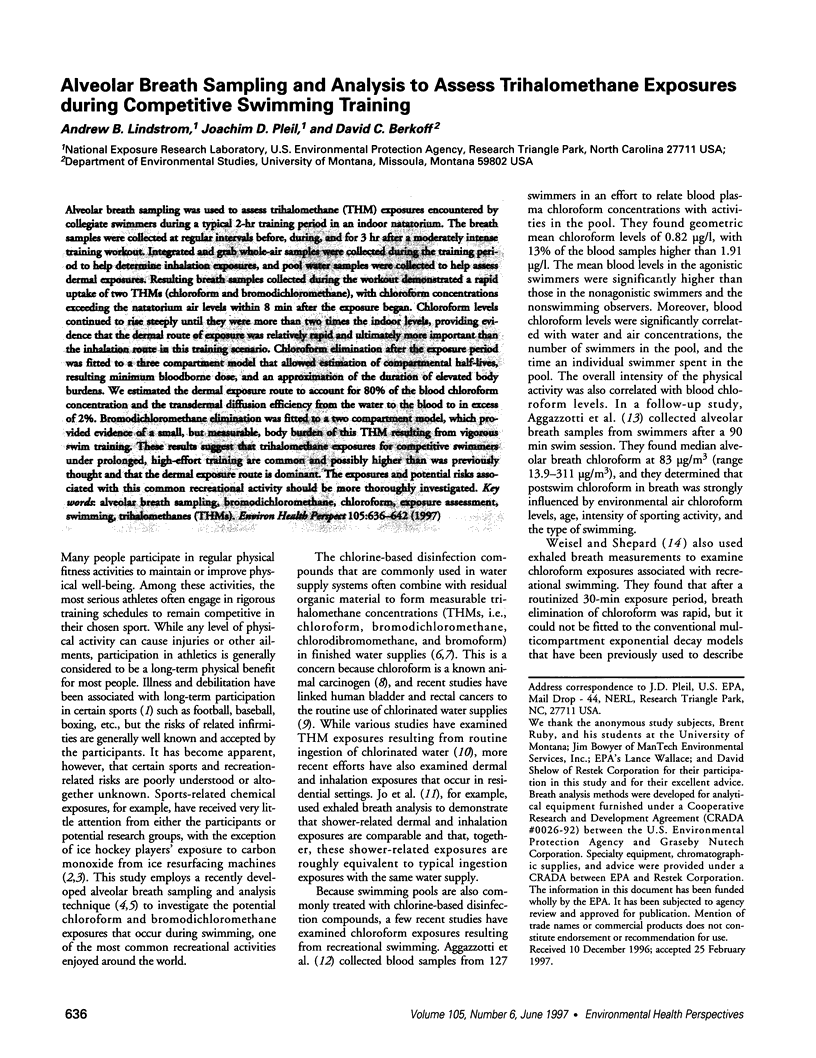
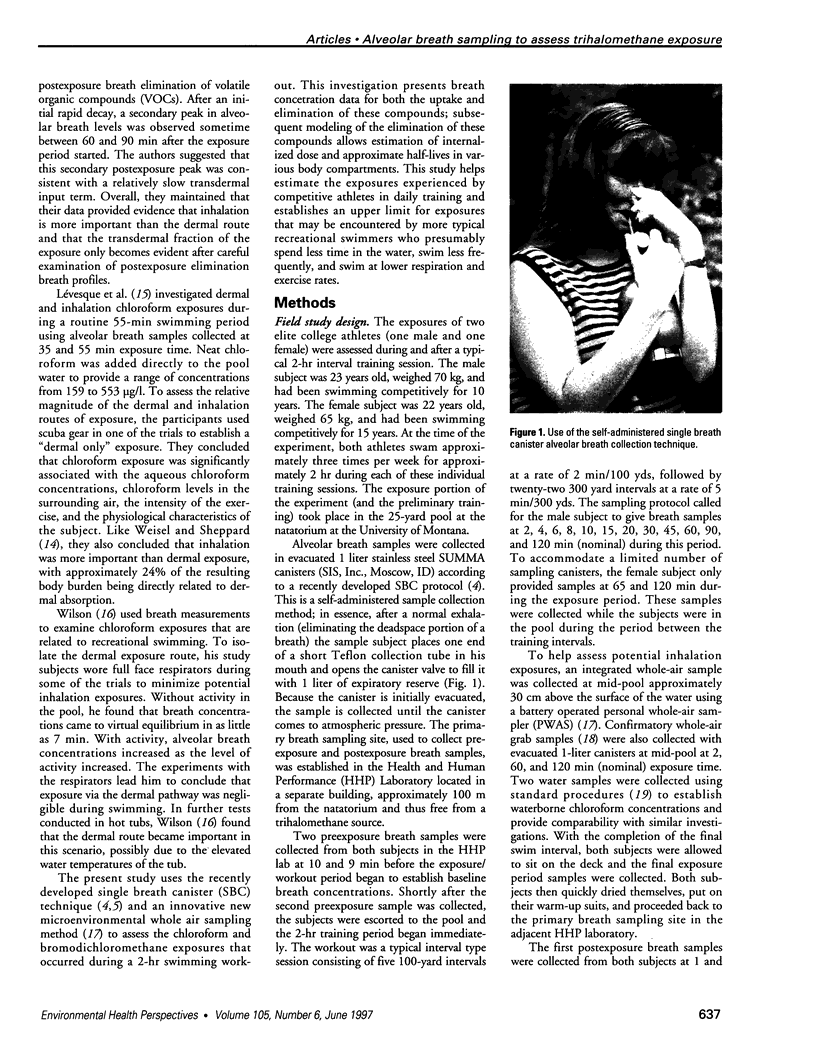
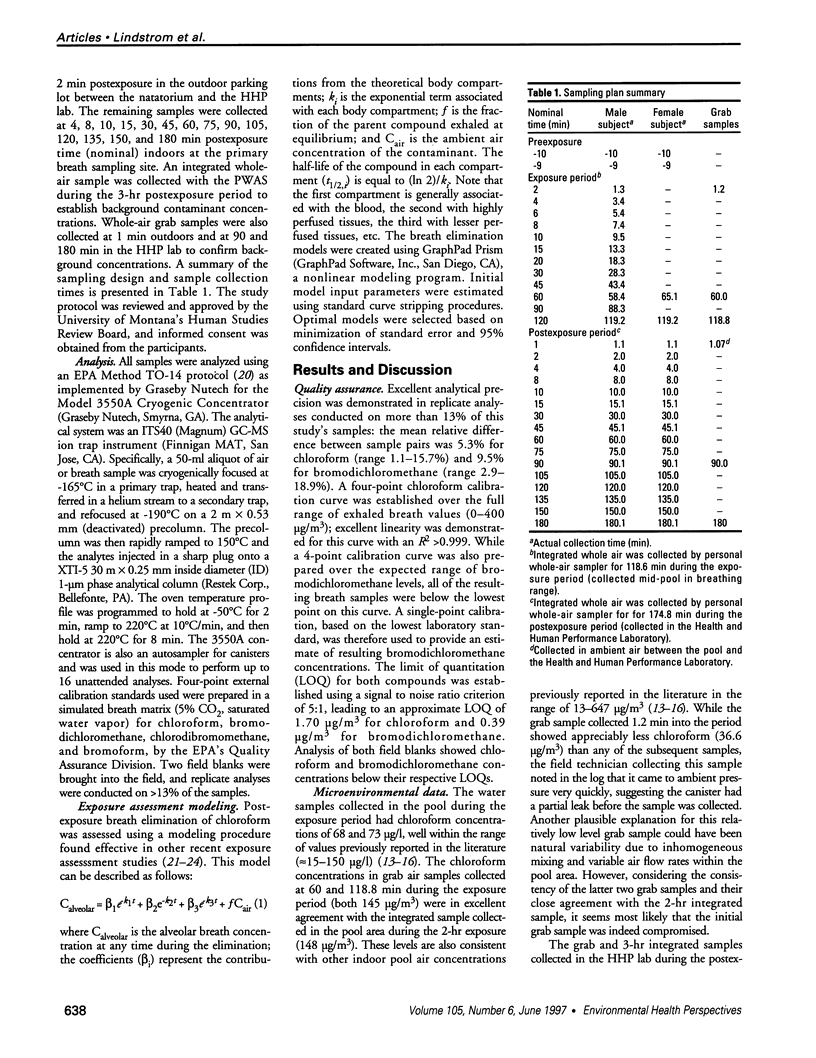
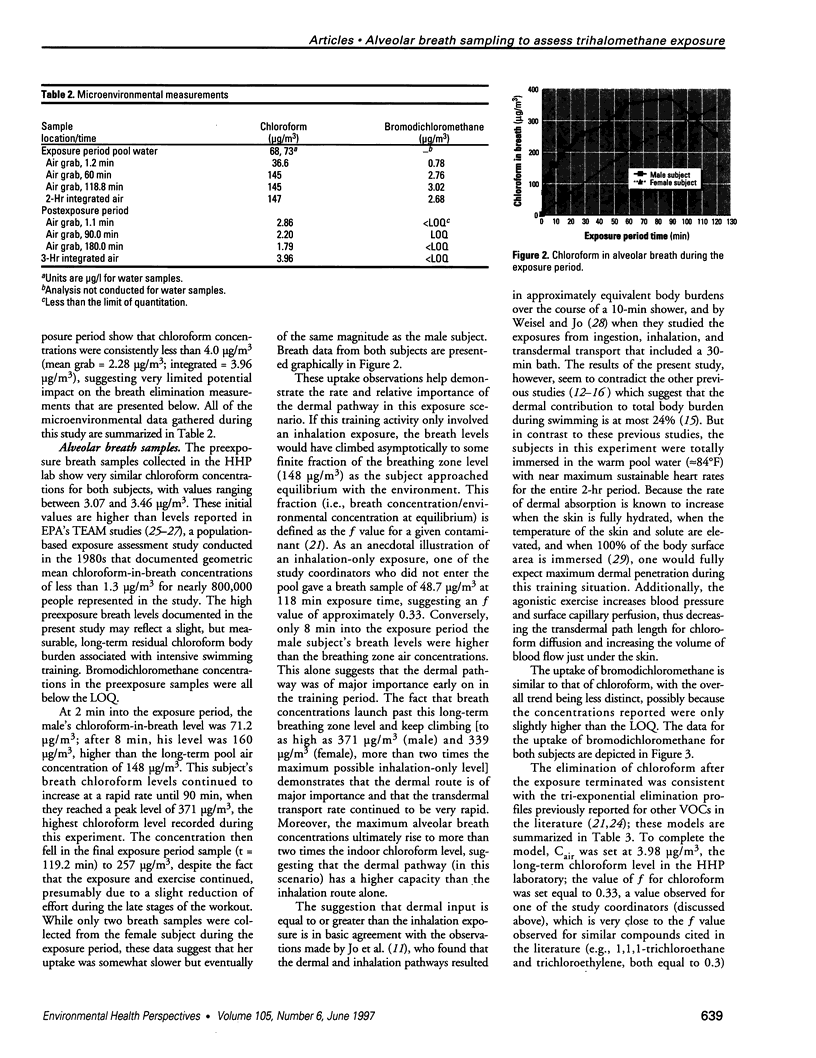
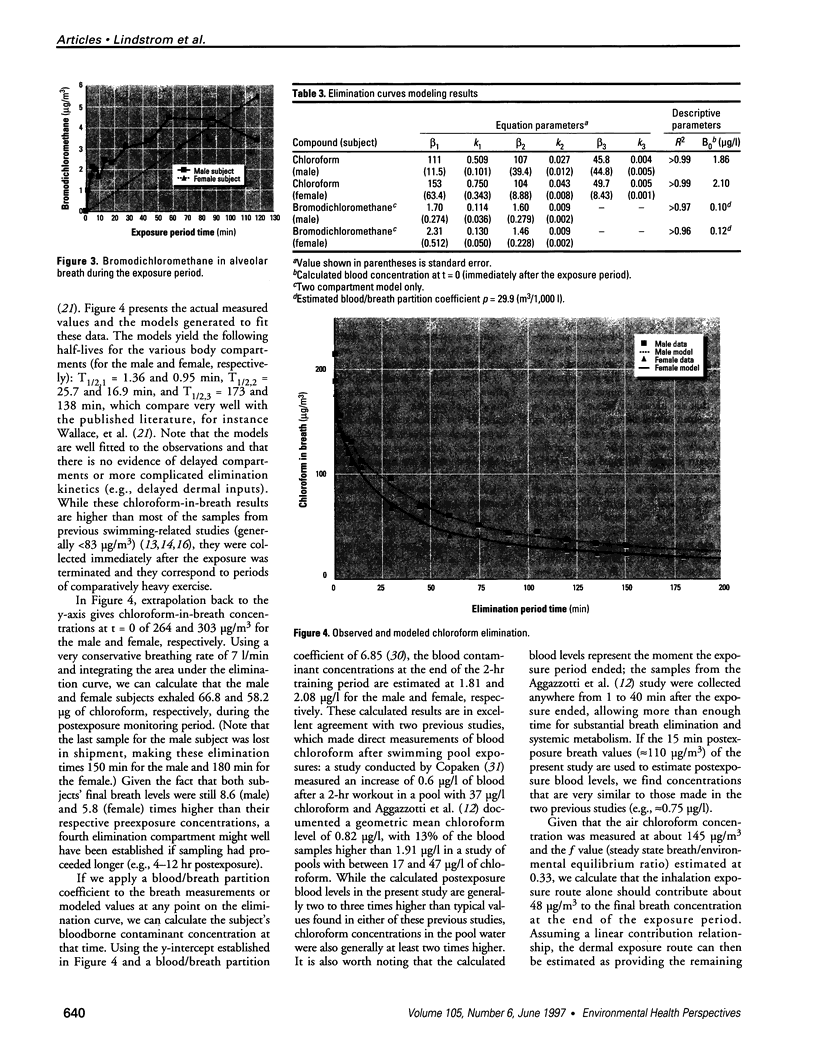
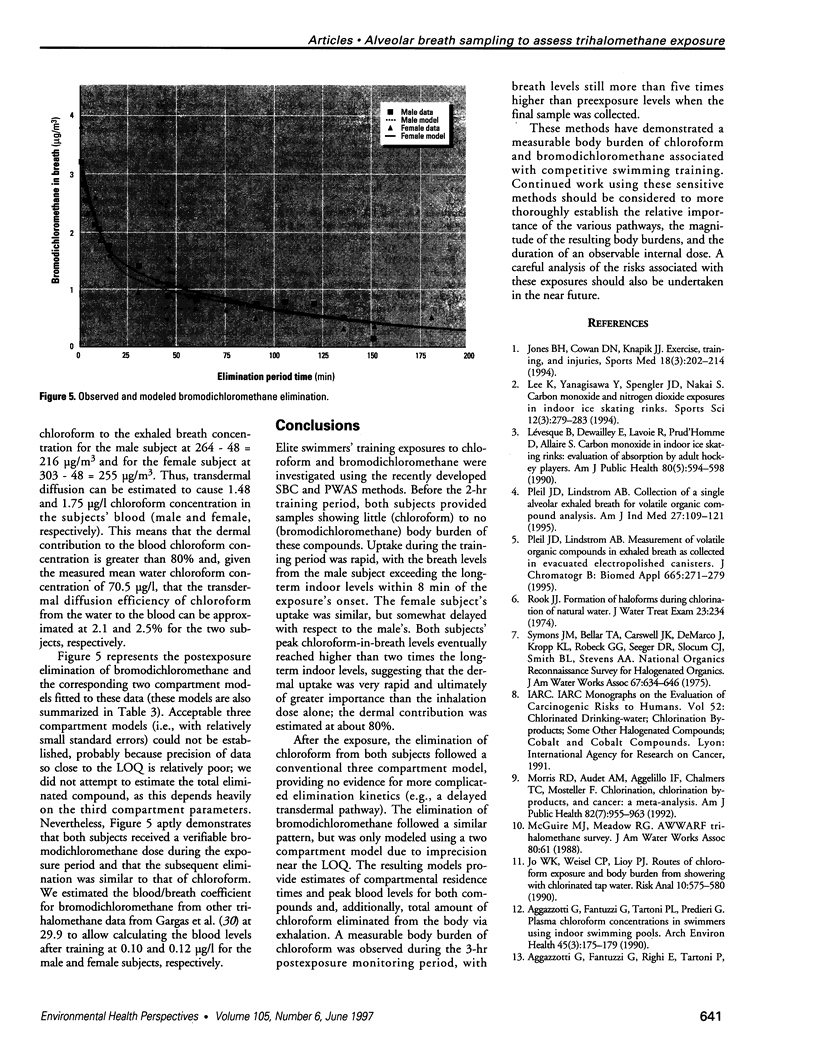
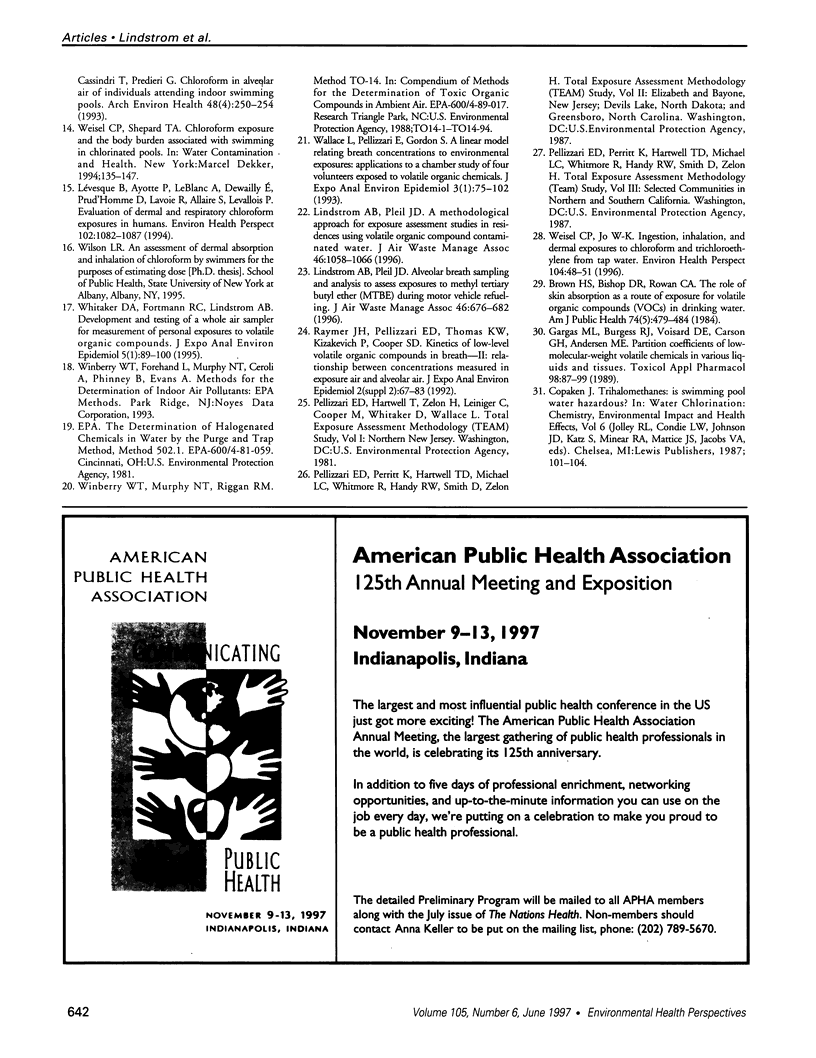
Images in this article
Selected References
These references are in PubMed. This may not be the complete list of references from this article.
- Aggazzotti G., Fantuzzi G., Righi E., Tartoni P., Cassinadri T., Predieri G. Chloroform in alveolar air of individuals attending indoor swimming pools. Arch Environ Health. 1993 Jul-Aug;48(4):250–254. doi: 10.1080/00039896.1993.9940368. [DOI] [PubMed] [Google Scholar]
- Aggazzotti G., Fantuzzi G., Tartoni P. L., Predieri G. Plasma chloroform concentrations in swimmers using indoor swimming pools. Arch Environ Health. 1990 May-Jun;45(3):175–179. doi: 10.1080/00039896.1990.9936712. [DOI] [PubMed] [Google Scholar]
- Brown H. S., Bishop D. R., Rowan C. A. The role of skin absorption as a route of exposure for volatile organic compounds (VOCs) in drinking water. Am J Public Health. 1984 May;74(5):479–484. doi: 10.2105/ajph.74.5.479. [DOI] [PMC free article] [PubMed] [Google Scholar]
- Gargas M. L., Burgess R. J., Voisard D. E., Cason G. H., Andersen M. E. Partition coefficients of low-molecular-weight volatile chemicals in various liquids and tissues. Toxicol Appl Pharmacol. 1989 Mar 15;98(1):87–99. doi: 10.1016/0041-008x(89)90137-3. [DOI] [PubMed] [Google Scholar]
- Jo W. K., Weisel C. P., Lioy P. J. Routes of chloroform exposure and body burden from showering with chlorinated tap water. Risk Anal. 1990 Dec;10(4):575–580. doi: 10.1111/j.1539-6924.1990.tb00541.x. [DOI] [PubMed] [Google Scholar]
- Jones B. H., Cowan D. N., Knapik J. J. Exercise, training and injuries. Sports Med. 1994 Sep;18(3):202–214. doi: 10.2165/00007256-199418030-00005. [DOI] [PubMed] [Google Scholar]
- Lee K., Yanagisawa Y., Spengler J. D., Nakai S. Carbon monoxide and nitrogen dioxide exposures in indoor ice skating rinks. J Sports Sci. 1994 Jun;12(3):279–283. doi: 10.1080/02640419408732173. [DOI] [PubMed] [Google Scholar]
- Lindstrom A. B., Pleil J. D. A methodological approach for exposure assessment studies in residences using volatile organic compound-contaminated water. J Air Waste Manag Assoc. 1996 Nov;46(11):1058–1066. [PubMed] [Google Scholar]
- Lindstrom A. B., Pleil J. D. Alveolar breath sampling and analysis to assess exposures to methyl tertiary butyl ether (MTBE) during motor vehicle refueling. J Air Waste Manag Assoc. 1996 Jul;46:676–682. doi: 10.1080/10473289.1996.10467502. [DOI] [PubMed] [Google Scholar]
- Lévesque B., Ayotte P., LeBlanc A., Dewailly E., Prud'Homme D., Lavoie R., Allaire S., Levallois P. Evaluation of dermal and respiratory chloroform exposure in humans. Environ Health Perspect. 1994 Dec;102(12):1082–1087. doi: 10.1289/ehp.102-1567469. [DOI] [PMC free article] [PubMed] [Google Scholar]
- Lévesque B., Dewailly E., Lavoie R., Prud'Homme D., Allaire S. Carbon monoxide in indoor ice skating rinks: evaluation of absorption by adult hockey players. Am J Public Health. 1990 May;80(5):594–598. doi: 10.2105/ajph.80.5.594. [DOI] [PMC free article] [PubMed] [Google Scholar]
- Morris R. D., Audet A. M., Angelillo I. F., Chalmers T. C., Mosteller F. Chlorination, chlorination by-products, and cancer: a meta-analysis. Am J Public Health. 1992 Jul;82(7):955–963. doi: 10.2105/ajph.82.7.955. [DOI] [PMC free article] [PubMed] [Google Scholar]
- Pleil J. D., Lindstrom A. B. Collection of a single alveolar exhaled breath for volatile organic compounds analysis. Am J Ind Med. 1995 Jul;28(1):109–121. doi: 10.1002/ajim.4700280110. [DOI] [PubMed] [Google Scholar]
- Pleil J. D., Lindstrom A. B. Measurement of volatile organic compounds in exhaled breath as collected in evacuated electropolished canisters. J Chromatogr B Biomed Appl. 1995 Mar 24;665(2):271–279. doi: 10.1016/0378-4347(94)00545-g. [DOI] [PubMed] [Google Scholar]
- Wallace L., Pellizzari E., Gordon S. A linear model relating breath concentrations to environmental exposures: application to a chamber study of four volunteers exposed to volatile organic chemicals. J Expo Anal Environ Epidemiol. 1993 Jan-Mar;3(1):75–102. [PubMed] [Google Scholar]
- Weisel C. P., Jo W. K. Ingestion, inhalation, and dermal exposures to chloroform and trichloroethene from tap water. Environ Health Perspect. 1996 Jan;104(1):48–51. doi: 10.1289/ehp.9610448. [DOI] [PMC free article] [PubMed] [Google Scholar]
- Whitaker D. A., Fortmann R. C., Lindstrom A. B. Development and testing of a whole-air sampler for measurement of personal exposure to volatile organic compounds. J Expo Anal Environ Epidemiol. 1995 Jan-Mar;5(1):89–100. [PubMed] [Google Scholar]







